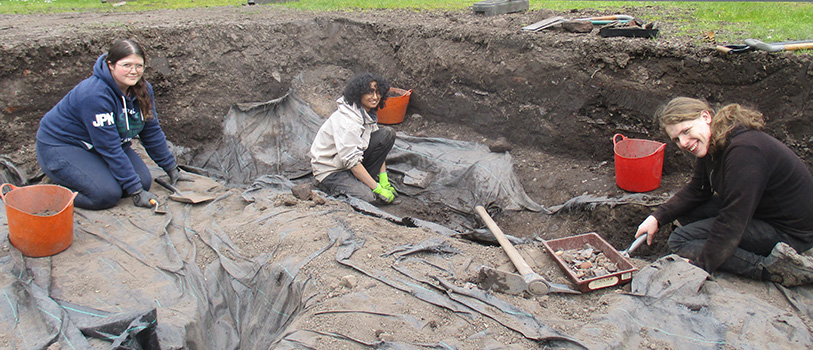The Grosvenor Park dig is back


Natasha, Ugiala and Chris excavating in Grosvenor Park
University of Chester archaeology students have returned to excavate in the city’s Grosvenor Park. Until Friday 17 May a new cohort of students will be developing their practical archaeological skills with local professional archaeologists.
As well as gaining valuable work experience, they will help to discover more about the past of this historic area of Chester. The excavation is run by West Cheshire Museums and is a partnership project between Cheshire West and Chester Council and archaeologists from the University of Chester’s School of Humanities and Social Sciences.
The excavation project began in 2007 with the aim of learning more about the landscape and growth of the area surrounding Chester’s Roman amphitheatre and the Church of St John the Baptist, an important church founded in the Saxon period.
The discovery of a Roman road and part of a large Saxon ditch have changed ideas about the archaeological significance of the park grounds, and a thick layer of debris from the destruction of a building during the English Civil War has produced the largest assemblage of 17th century military equipment to be found in Chester.
These discoveries have prompted more questions such as:
- Do remains survive of the pre-Roman landscape?
- Were there any Roman buildings alongside the road?
- Was the Saxon ditch part of a fortification and does it run south towards the river?
- Is the destruction debris from the house constructed by Sir Hugh Cholmondeley in the late 16th century and destroyed in the Civil War?
- Does anything survive of the medieval buildings that preceded the house and were part of the precinct of St John’s Church?
A greater number of students want to take part this year so the excavation trench from 2023 is being extended to the west to re-open an area last seen in 2021 where traces of a late medieval or 16th century building were found.
One of this year's aims is to find out more about this building and how it relates to a medieval building found to the north several years ago and Sir Hugh Cholmondeley’s house. The Saxon ditch should run across this area, and it might be possible to find its outline. The team is also hoping to find more evidence of the Civil War and its impact on the area. Or something totally unexpected may be waiting to be discovered.
A free to visit open afternoon will be held on Tuesday 14 May, from 1.30 pm to 4.30 pm, to see what has been found; no booking is necessary. Visitors are also welcome to view the excavation, Monday to Friday from 9.30 am to 12.30 pm and 1.30 pm to 4.30 pm, when students will be pleased to answer questions about their work and discoveries.
The excavations have inspired more collaborative work between West Cheshire Museums and the archaeology team at the University. Students have worked with museum staff to create exhibitions that include finds from the Park; the current exhibition 'Royal Rumble' at the Grosvenor Museum until 2 June focuses on Chester in the English Civil War. Further information can be found at:
Digital technology and 3-D imagery are also being explored to find ways of presenting the discoveries to wider audiences. The University's Digital on Tour team have been using a drone to scan the excavation trench and create virtual reality tours that allow people to explore the trench wherever they may be. Plus 3-D scanning of artefacts is being used to create an on-line exhibition; the first results are now available:
Visitors to the open afternoon can learn more about Digital on Tour, try the VR tour and watch as artefacts are scanned and 3-D printed.
Students and staff will be posting regular updates on social media channels; follow #DigChester to keep track of this year’s discoveries:
- X (Twitter): @cwacmuseums and @HistArchChester
- Facebook: Grosvenor Museum And Stretton Water Mill and Archaeology, University of Chester
- or HistArchChester on Instagram
Anyone interested in an archaeology degree can find out more at:
